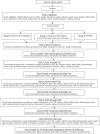Preventing post-stroke dementia. The MARCH Trial. Protocol and statistical analysis plan of a randomized clinical trial testing the safety and efficacy of Maraviroc in post-stroke cognitive impairment
- PMID: 36082248
- PMCID: PMC9446318
- DOI: 10.1177/23969873221098857
Preventing post-stroke dementia. The MARCH Trial. Protocol and statistical analysis plan of a randomized clinical trial testing the safety and efficacy of Maraviroc in post-stroke cognitive impairment
Abstract
Background: Current evidence suggest that 25%-33% of stroke-survivors develop post-stroke cognitive impairment (PSCI). The licensed drug Maraviroc, a CCR5-antagonist, is postulated to act via a neuroprotective mechanism that may offer the potential of preventing progression to vascular dementia. Our hypothesis: Maraviroc may have the potential to augment learning skills and cognitive performance by affecting synaptic plasticity, along with neuro-inflammatory modulation in patients with cerebral small vessel disease (SVD) and PSCI.
Design: MARCH is a multi-center, double-blind randomized-control Phase-II trial of Maraviroc 150 or 600 mg/day versus placebo for 12-months in five stroke centers in Israel. Included are patients diagnosed with recent (1-24 months) subcortical stroke who experience mild PSCI and have evidence of white matter lesions and SVD on neuroimaging.
Outcomes: Primary outcomes: 1. Change in cognitive scores. 2. Drug related adverse events. Secondary outcomes: change in functional and affective scores, MRI-derived measures, inflammatory markers, carotid atherosclerosis, cerebrospinal-fluid biomarkers in a sub-study. A sample size of 60 in each treatment group and 30 in the placebo group (total - 150 participants) provides 80% power between the treatment and the placebo groups.
Conclusions: The results of this work could lead to a novel, readily available, therapeutic avenue to reduce PSCI, and possibly other pathologies. This study will test safety and effectiveness of Maraviroc in limiting cognitive deterioration and/or post stroke cognitive impairment in patients with cerebral small vessel disease.
Schedule: First-patient first-visit was May 2021. Recruitment to complete in 2023, follow-up to complete in 2024.
Keywords: Maraviroc; Post-stroke dementia; randomized controlled trial; white matter hyperintensities.
© European Stroke Organisation 2022.
Conflict of interest statement
Declaration of conflicting interests: The author(s) declared no potential conflicts of interest with respect to the research, authorship, and/or publication of this article.
References
-
- Pimentel-Coelho PM, Rivest S. The early contribution of cerebrovascular factors to the pathogenesis of Alzheimer’s disease. Eur J Neurosci 2012; 35: 1917–1937. - PubMed
-
- Kalaria RN. Cerebrovascular disease and mechanisms of cognitive impairment: evidence from clinicopathological studies in humans. Stroke 2012; 43: 2526–2534. - PubMed


